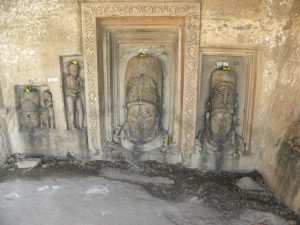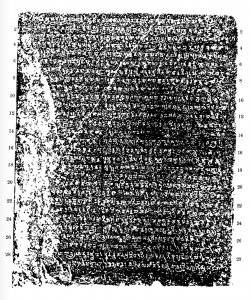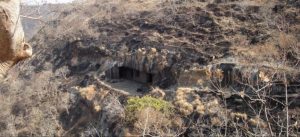INIG1283g Chanderi Inscription of VS 1283g
INIG1283g Chanderi (Guna). On the pedestal of a colossal image in a cave shrine, Khandhāgiri digambarjainkṣetra. 2 lines, nāgarī, Sanskrit. Indifferently engraved; mentions several persons like Śricanda, Kanakacanda, Deucanda. Purport unclear.
INIG1281c Chanderi Inscription of VS 1281c
INIG1281c Chanderi (Guna). On the pedestal of a colossal image in a cave shrine, Khandhārgiri digamba-rjainkṣetra Number of lines not given, nāgarī, Sanskrit. Indifferently engraved; records the obeisance of some persons (names not clear).
Kalinjar Inscription of Bhāvasomeśvara
This inscription accompanies an ascetic figure with jaṭāmukuṭa in one of the caves on the path leading to the Nīlakaṇṭha temple at the hill fortress of Kalinjar in the Banda district in Bundelkhand, Uttar Pradesh. The figure of the ascetic is carved to the left of an ekamukha liṅga. next to The name Bhāvasomeśvara indicates a Pāśupata ascetic (names starting with Bhāva- are a common feature of Pāśupatas and there is much other evidence for the presence of Pāśupatas at Kalinjar). The same name is know from a 12th-century pedestal inscription of a Śaiva ascetic at Menal (Rajasthan), another Pāśupata centre.

Ekamukhaliṅga shrine of the Bhāvasomeśvara inscription
OB00167 Verandah of Ajanta Cave 17
OB00165 Verandah of Ajanta Cave 16
OB00166 Verandah of Ghatotkaca Cave at Gulwada
OB00141 Gopika Cave on Nagarjuni Hill
OB00140 Vadathika Cave on Nagarjuni Hill
OB00139 Lomasa Risi Cave on Barabar Hill
IN00180 Ajanta Cave 17 Inscription of Ravisamba

This stone inscription, inscribed on the side wall of the outside veranda of cave 17, is much damaged by exposure, which according to Shastri (1997: 46), has lead the correct decipherment of the inscription to be very problematic. The inscription starts with a dedication to the Buddha, unusual as many of the Vākāṭaka period inscriptions and charters are dedicated to Hindu gods. The inscription was carved to record the creation of Buddhist stupas and institutions by a ruler called Dharādhipa and with the wish for the longevity of these structures. The inscription was carved under the name of Ravisāmba, a vassal of the Vākāṭaka king Hariṣeṇa. The inscription also includes a genealogy for Dharādhipa and Ravisāmba.



